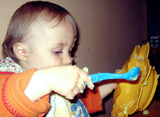Examination of phthalate exposure in the diet of toddlers

Phthalates have been used for over 40 years by industry on a large scale. Their physicochemical properties make them particularly useful as plasticizers in soft-PVC. They are also used as additives in cosmetics, pharmaceuticals, textiles, adhesives, paints and pesticides, meaning that phthalates are omnipresent and that the general population is unavoidably exposed to them.
The former study entitled Integrated Exposure Assessment Survey (INES) measured and quantified phthalate uptake by a group of 50 adults from Bavaria via the food pathway.
It is known from experiments on animals that the toxicological effect of phthalates is particularly evident in young animals.
Chemical analysis of food duplicates for phthalates
The objective of the study which is now being carried out is to measure the daily uptake of phthalates from foods by small children. The supervision of the probands and the sampling are being undertaken by the Bavarian Health and Food Safety Authority (LGL), and the Fraunhofer IVV is undertaking the complex chemical analysis of the phthalates.
In this study, duplicate quantities of the foods eaten by the probands over several days are being collected. After homogenization, the samples are being analyzed for plasticizers. The resulting daily uptake rates are being compared with the toxicologically acceptable daily uptake rates for the individual plasticizers and will so form the basis for any recommended action.
Project term: |
2009 |
Project management |
Bavarian State Ministry of the Environment and Public Health (StMUG) |
 Fraunhofer Institute for Process Engineering and Packaging IVV
Fraunhofer Institute for Process Engineering and Packaging IVV